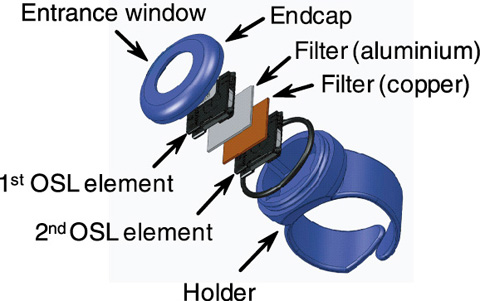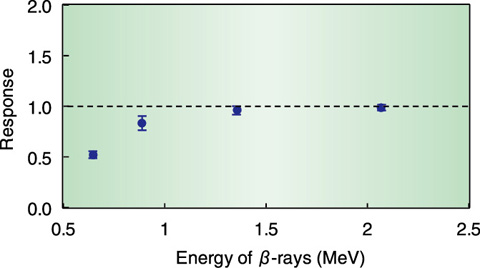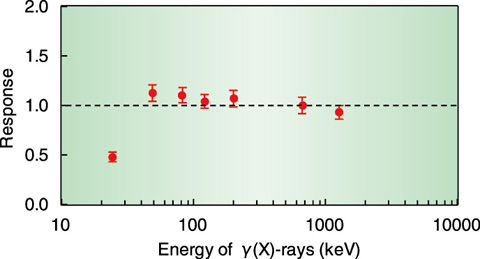
Fig.13-3 Composition of the OSLRD

Fig.13-4 Energy dependence for β-rays

Fig.13-5 Energy dependence for γ(X)-rays
Measurements of hand exposure doses are required for radiological decontamination work, because exposure doses to hands are often higher than those to human bodies. Hand exposure doses had been measured with ring-type thermoluminescence dosemeters (TLDs) in the Nuclear Science Research Institute. However, TLDs have some disadvantages, such as short-term stability (only one month) and a destructive readout process in which all dose information is lost in a single readout.
In recent years, an optically stimulated luminescence (OSL) technique has been successfully applied to many dosimetry problems. OSL dosemeters offer the advantage of long-term stability and allow repeated readouts. To overcome the difficulties associated with hand exposure measurements using TLDs, we developed a new ring-type OSL dosemeter (OSLRD) using compact water-resistant OSL elements produced by LANDAUER INC. (Fig.13-3). The shape of the ring was designed to maintain workability and ensure performance of the OSLRD.
Irradiation tests using β- and γ(X)-rays in standard radiation fields and Monte Carlo simulations were conducted to evaluate the performance of the OSLRD. The energy dependence of the OSLRD was within ±15% for both β- and γ(X)-rays (Fig.13-4, Fig.13-5). These values are lower than the values (±30%) required by the Japanese Industrial Standards for the energy dependence of OSL elements. We also confirmed that the OSLRD discriminates between β- and γ(X)-rays for various types of radionuclides and that the OSLRD operation is stable for three months.
The reliability of hand dosimetry was improved using the OSLRD developed in this work. The OSLRD has sufficient performance for a dosemeter and allows repeated readouts of dose information. This OSLRD has already been placed in practical use in JAEA, and it is expected to be widely used in many different types of radiation work.